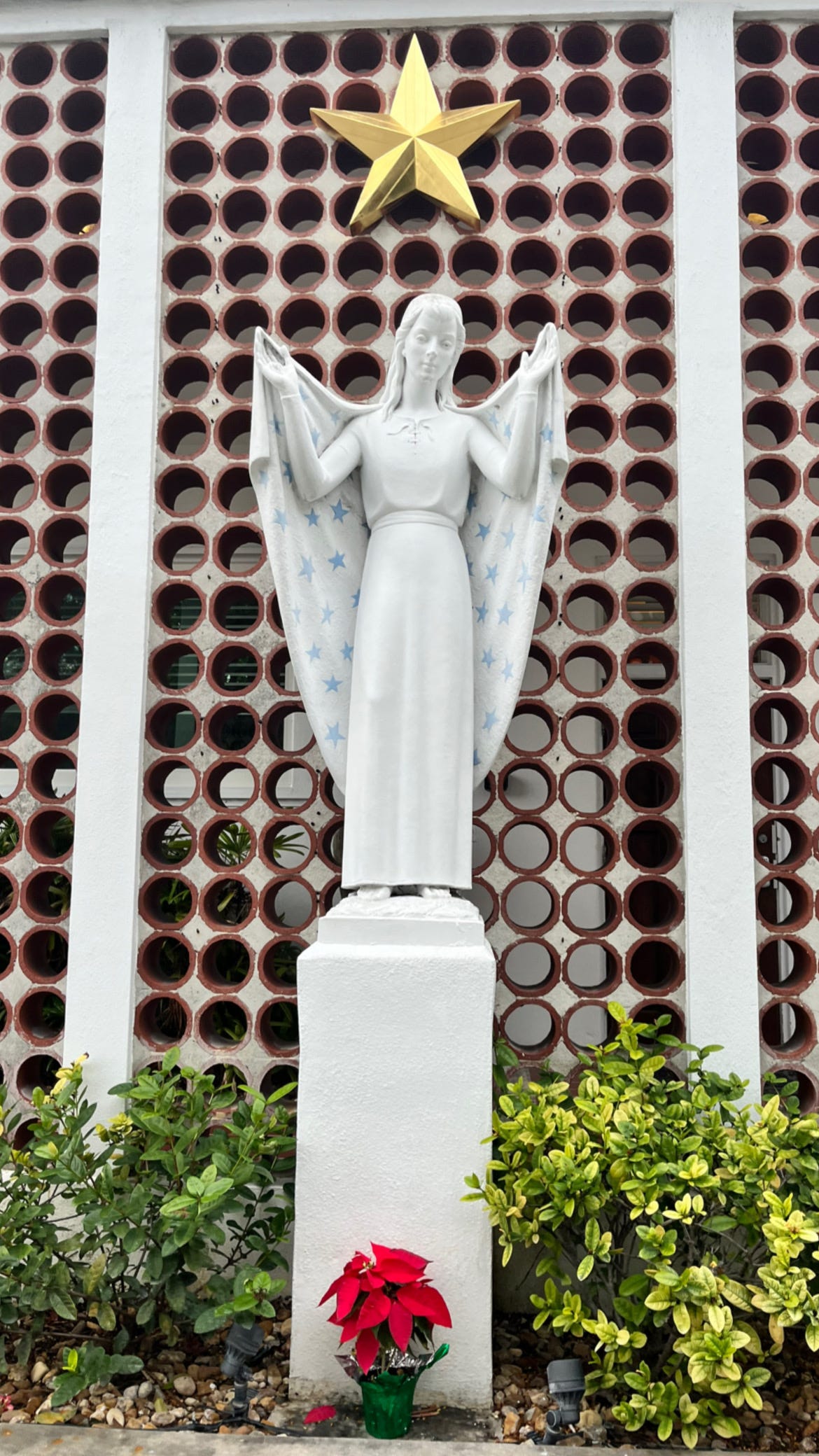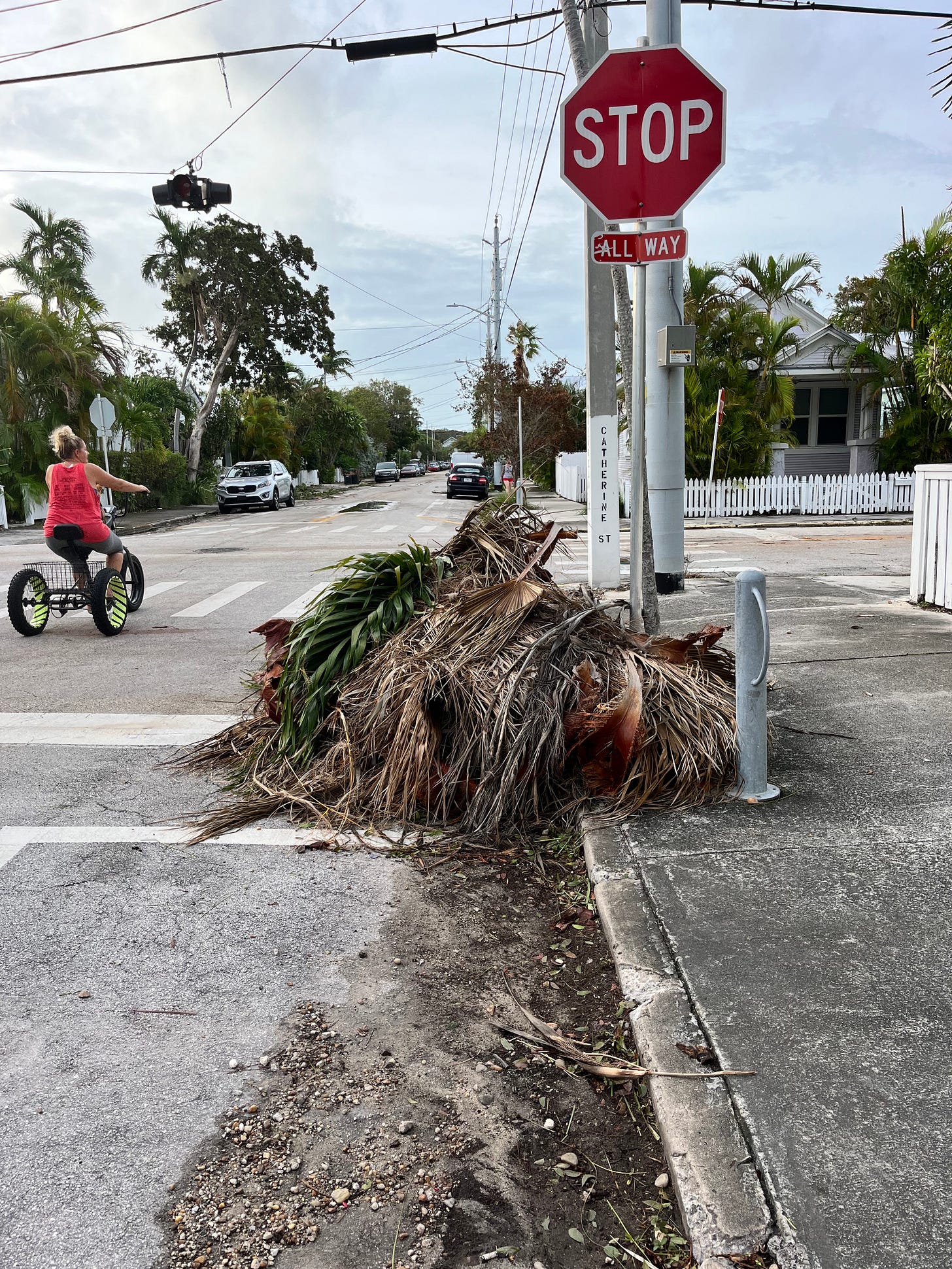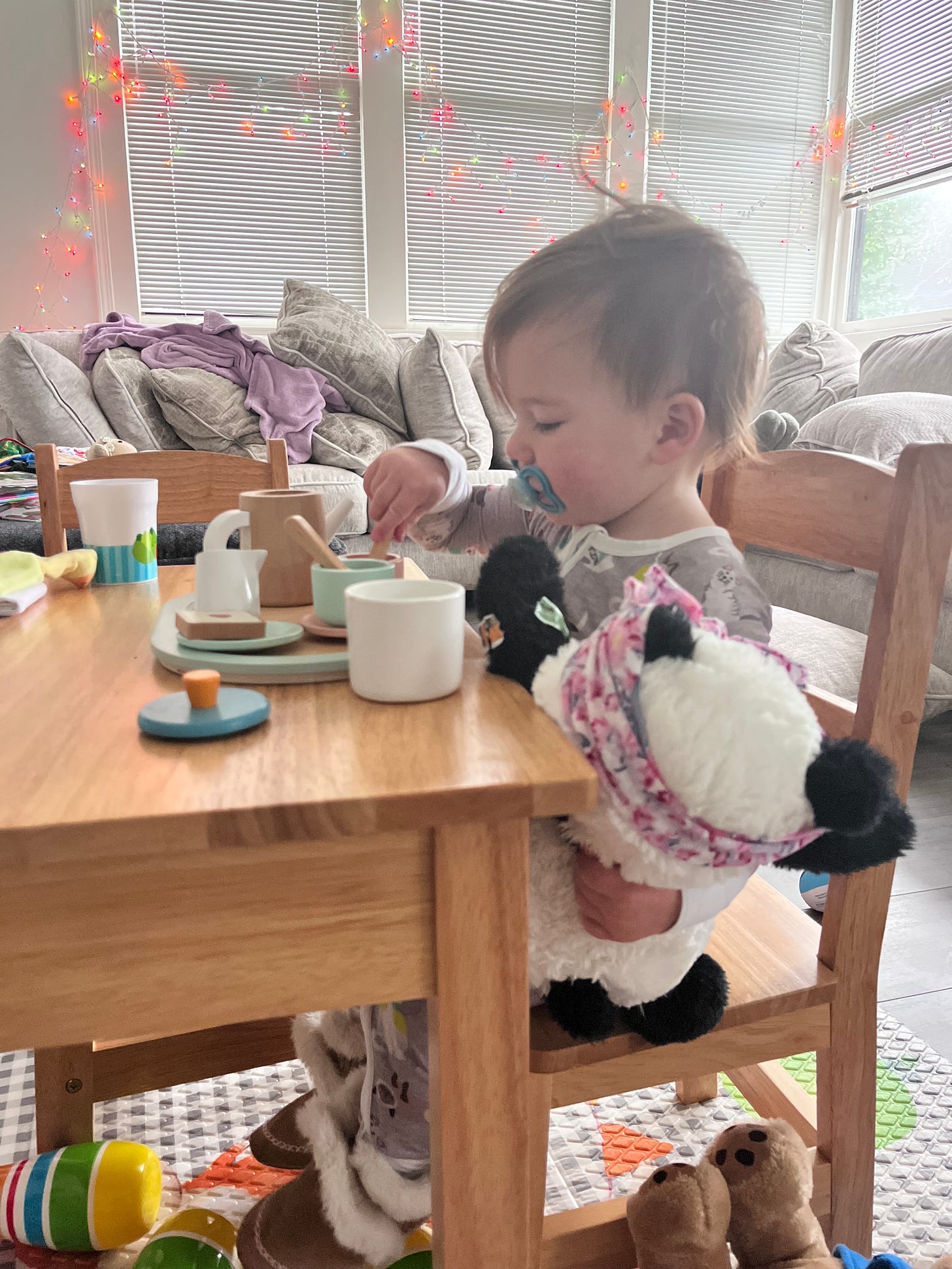(Note: Always Secure Heads to Bodies)
On the LA Fires, Hurricane Ian, illness, possession, what we take, and in taking--what we choose to leave behind
This morning at 9:30 I will go under general anesthesia for a EGD, or an endoscopy.
If I’m being honest coming to terms with the unknown, the “after” of the procedure has been terrifying. I know I feel nauseous and am not eating like I did. I know my stomach feels strained, my ribs tender, sore. Sometimes food pools where it should not. Always, there is the burning, vague and diffuse. Sometimes there is another burning. Specific, triangulated, alarming. At night, when I lay back to feed my baby, I convince myself I feel my throat is pulsating and think maybe the burning that is specific—alarming—is really a growth. Blood moving, blood making a tumor’s ready supply. For me, this is not some hypochondriac’s wet dream, or even a distant possibility.
The facts are these.
I have been sick for ten years.
I have had reflux everyday for ten years.
Medication hasn’t worked.
Surgeries haven’t work.
I have tried every doctor, while crying.
And, after recognizing I really, really tried, I stopped with the doctors and the crying.
Until now.
Now I worry I won’t see my baby grow.
Now, I worry there will be no Mama pajama pant to tug on when bedtime is near.
Now, I worry I’ll have to turn to AI for futuristic photos of my five year old, ten year old, teen.
Now, I worry that I’ll miss her and that she’ll miss me, or not know what parts of me there were even to miss.
Now, I worry I’ll leave in my place, stead: a hole. Long and dark and empty.
*
There’s a dress from Pepa London I have been visiting online, wanting to buy it for Aoife—maybe anticipating a hole or feeling a hole tunneling in her life.
It is a smocked dress with "vintage charm" and a “bespoke floral print." 100% cotton. Made in Spain. It is red, and Size 2T.
There is also a book I’ve been meaning to buy her. The Hundred Dresses is a favorite from my childhood.
I want to buy these two things now, but my January has been slow to start work-wise, and so this want is hard to justify. Yet, I continue to think of both. No, that’s not true. I constantly dream of, even yearn for both. And, I work in an outsized though increasingly empty way to make the getting, buying, attaining happen.
I wake up to tend my email like a tiny troll under a sinking bridge, I send emails with abandon, I circle LinkedIn like a vulture to see the latest from those who are similarly circling LinkedIn, vulturelike. My desire to possess making me a person possessed, and on LinkedIn I become a budding pick-me girl. I ‘thumbs up’ and ‘heart’ it all: VCs posting lighting ⚡️ emojis to celebrate round tables on nuclear energy, solopreneurs starting pitches with “Everything is Sales, Sales is Everything,” creatives telling me why the long sentence need to be reclaimed—why I a “sometimes copywriter” now need to be a “copywriter-turned-Proust.” The worst in this terrible stream of import being sonatas of trauma-turned-self congratulation, which I also—without discretion—‘love’: professional discoveries made in near-fatal car crashes and terminal illness scares; pats on the back spurred by traumatic childhood events—violent crime and bullying, food stamps, homelessness.
War stories traded for goods and services rendered.
Life distilled to marketable key takeaways, bullet points. Bullet points marked by red and yellow rocket ship 🚀 emojis.
Pain yoked to worth, worth of the corporate kind.
Did I say I am a woman and a woman possessed and a woman possessed with a magic mouse and trackpad?
*
In 1961, Joan Didion published an essay on self-respect in which she wrote "To have that sense of one’s intrinsic worth…is potentially to have everything." Through The World According to Didion, however, I learn Saint Joan was not immune to the corporeal: stays at the Royal Hawaiian, French perfume, good silver, tablecloths on rollers, a layette from Saks when her baby was born. In fact, the woman whose writing was truly immaculate may have penned one of the world’s most famous packing lists, rivaling only Vogue’s 1970s egg-steak-black coffee-wine diet. Included? Two skirts, two jersey or leotards, one pullover sweater, two pairs of shoes, a mohair throw, robe, slippers, cigarettes, bourbon, aspirin, two legal pads, a typewriter.
Image from Joan Didion: What She Means; Didion Corner, Captioned, 2022
(Barbara Bloom, American, b. 1951), Collection of Dr. Jennifer M. Walske
Just one short week ago, as the LA fires swept through the Palisades and Malibu—where Joan once lived, New York Magazine’s The Cut interviewed people fleeing, asked them—curiously—what they packed, or more accurately worded, “took.” The responses varied.
Some seeming to have more warning, more time, spoke of the obvious: photos, family heirlooms, jewelry. Others, rushed, picking mere symbols of lives once lived. One newly employed man said, "Never in my life would I have bought a $400 jacket before, and I took that." Another woman took a copy of her marked-up Virginia Woolf’s To the Lighthouse from college, saying "it sounds like it’s a joke but it’s true." Still, another woman bagged her many journals, stating, "I’ve journaled for ten years. I’m a pretty good memory keeper for my friends and community. I do reread them a lot. I put all of them in a grocery bag." In a separate television interview, the B-list celebrities Heidi Montag and Spencer Pratt noted the first things they grabbed when the house caught fire: their children's teddy bears.
For those that know it, have read it, and for those that haven't and likely won't, The Hundred Dresses is a story of a poor Polish-American girl Wanda who wears a solitary blue dress to school day after day after day. After being teased, bullied by classmates, she reveals she possesses not just this single, faded blue dress but in fact 100 dresses, 100 dresses that line her old closet, a closet that sits in her rundown house. For this claim she is ridiculed, mocked—demanded by the girls in her class to show them her gowns, shifts, frocks. Inopportunely, at the time when her family makes the decision to leave the discriminative town, her teacher holds a contest—specifically, a drawing contest in which the girls in the class are asked to draw dresses of their own imagining. Wanda, in her worn blue dress, enters 100 beautiful designs. Her classmates in awe, shock, surprise, write her a celebratory note. But it’s too late. Wanda has left—her family driven away by the town, its cruelty. Possession coming from the Latin possessus, the past participle of possidere, which is likely a compound of potis "having power, powerful, able" and sedere, from the root "to sit."
*
When I left Key West to bring Aoife into this world, I brought very little with me. In fact, I left my favorite dresses behind. Caftans, block-printed and striped—all made in India. I later wrote in a social post the things I missed being pregnant, including my dresses. At the end of the post, I double downed, writing, “Did I say I miss my dresses?”
When I stayed in Key West as the Category One Hurricane Ian hit in 2023, I didn’t think I had to think what I might have to take if the storm strengthened and evacuation was mandated. T had been sent to sea with his Coast Guard fleet—as boats at the pier are prone to leave in big storms, and I was left alone to ride it out, pray at Our Lady of Lourdes Grotto at The Basilica of Saint Mary Star by the Sea, a grotto made of local coral in 1922 and believed by the islanders to ward off storms.
Image Our Lady of the Sea statue, Windsor Lane
The night the hurricane hit, I wrote intently in my journal:
Moved from the living area to the bedroom. Grabbed knife and fire extinguisher, bottle of wine. Storm is heightening as eye parallels Key West. According to NOAA, the worst of it is now–four hours on either side of 9 PM.
Keep hearing dripping noises but unsure where they are coming from. Realize I am learning about what’s happening on the street outside from a machine in my bedroom. A photograph online of cars lining the corridor of Big Pine Key, which I try to make sense of. A photograph of a woman in a green shirt walking her dog–likely on or near Eaton–in knee-high water, which I also try to make sense of.
Hear the first sirens of the night and wondering what happened, is currently happening. If there is a person under a branch or a wall or a tree. I read just an hour ago a man from Cuba was electrocuted while trying to disconnect a wind turbine that he uses to irrigate his field. I think what a terrible way to go.
Certain now a large branch fell on porch.
(Note: the succession of a hurricane, the little markers of time. Old berries and then new berries and then the tiny branches with the waxy green leaves containing the new berries and then the browned palm fronds and the larger, healthier limbs being torn, tossed.)
(Also, note: Sarah Manguso writes that narratives in which one thing follows from the previous thing are usually imaginary.)
Wind now mimicking waves in a rush and then a cool/calm and then a rush, rumble, cool/calm. Hard to see anything out of french doors, which are draped in fabric shutters. Hear slight clanging. Suspect it has come from a propane tank I failed to secure near a pile of loose bricks, or the large white plastic bucket with the pool’s chlorine tablets I tried to pin down near a corner of the house. Go to inspect and see, instead, top of lamp on pool deck downed—ripped off by its head. That the pole is now headless. That its head—white, opalescent—is lolling about on the wood.
(Note: always secure heads to bodies).
At one point, when Ian’s wind got too loud, I had the thought to hole up in our closet, under my dresses—block-printed and striped. In that moment of desperation, I held only three worldly possessions: a half-drunk bottle of wine, a kitchen knife, and the blue light of a flickering screen.
I also had the thought if I had to leave and what might I carry. I decided on everything in my arms. I decided my favorite books, computer, and a painting T commissioned for me by the local Haitian artist Jean-Paul, known for his vibrant acrylics of roosters and palm trees, topless women.
At midnight, when the howling heightened to that of a thousand coyotes, I left my bedroom and took none of what I proposed taking. Instead, using a hallway flashlight and camera, I filmed the palms and the palms’ shadows dancing.
*
This month, Aoife has taken to touching her dresses. Cotton and polyester, floral, and stitched. She also has taken a liking to a particular basket—one that holds bows in every color and several cloth coronets and crowns, including one that is pink and green and has her vowel-full name stitched across it in effortless cursive. She cups her hands in the basket, in the sink of color, and then throws the bows in the air. She kicks them across the mahogany floors with her tiny fur boots, pudgy Disney-like feet. She gathers them in her arms—hugs them tight, like babies.
I'm not sure what I've taught her, am teaching her. Perhaps that when she wears a bow—purposely placed to mask her hemangiomas, the bow is like a finishing touch. A proper ribbon to a gift. Or, perhaps, she is beginning to learn about abundance, what it is to "have." Most, likely, though, she is simply in love with the vibrancy, the color. She particularly likes one headband with its splotched purples and pinks, deep orchid blooms—running down the hall while waving it wildly in her hand, placing it on Pandie, on Mr. Sloth, on Joseph the Giraffe, then placing Pandie, Mr. Sloth, and Joseph the Giraffe on tiny chairs, then subsequently pouring them imaginary milk and tea.
*
Last week on TikTok, I watched videos of Biden's farewell address, saying America was sliding into an oligarchy, and beneath one reel, I saw someone comment, "The best way to keep a prisoner from escaping is to make sure he never knows he's in a prison." I now see the girls in A Hundred Dresses, the ones who teased Wanda as being, in fact, trapped—by the idea of material wealth and, in turn, excessive consumption, not creativity—as worth. I also now think the best way to keep a prisoner from escaping is to not to make sure he knows he’s in a prison but to give them a little piece off that prison—however small, and let him call it—the prepaid phone cards, extraneous candy, a $400 jacket, the Daytona-yellow Stingray, a tiny cursived crown—his own.
And, yet, don’t our things become us?
*
In the end, I did buy Aoife the dress. It arrived Tuesday—two days before today, my scheduled endoscopy. The dress speckled with more yellow flowers than I had even anticipated, than Aoife could ever desire. But I also bought her the book. The illustrations of long flowing gowns and floral patterns and sunlit hues—like the dresses themselves—all made simply, of paper.
I can only hope if it’s her time to flee—from storm, fire, flood, Aoife is quick to decide. And, that there will also still be a Mama to help fill in the holes with bows and the crowns and stuffies that drink imaginary tea and the strength of Mama over many, many years and her fear on one particular day—that day with the island and the palms that shimmied and the lamp’s head that lolled and the wine and the knife and sound and sound’s cleaving, and one painting with its bright tenor and women’s looping breasts and the feel of Mama’s dresses. Mama’s dresses—block-printed, striped. Swishing.







